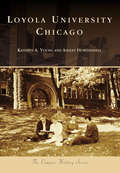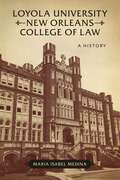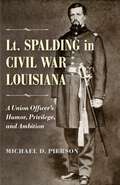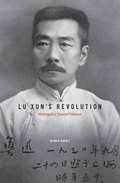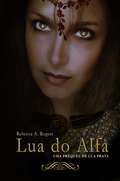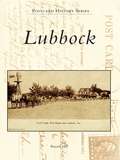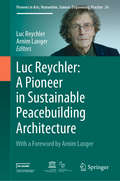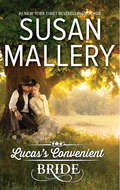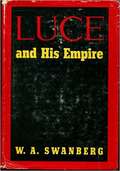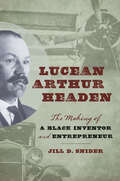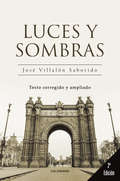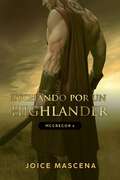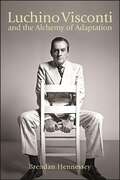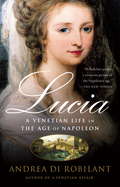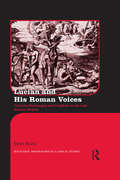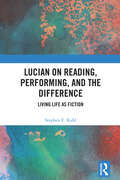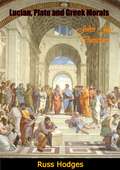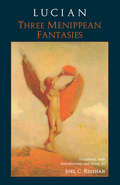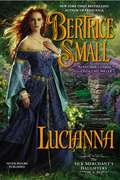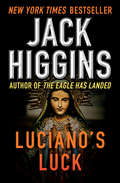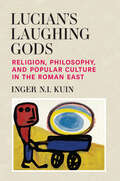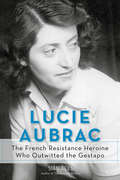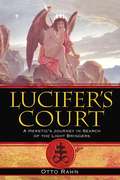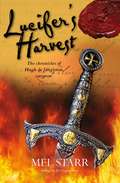- Table View
- List View
Loyola University Chicago (Campus History)
by Kathryn A. Young Ashley HowdeshellFor the past 150 years, since its founding in 1870 as St. Ignatius College, Loyola University Chicago has served and educated both the immigrant and established residents of Chicago, excelling in providing a comprehensive liberal arts education. One of the largest Jesuit universities in the United States, Loyola Chicago offers over 80 undergraduate and 170 graduate and professional programs in the humanities, sciences, medicine, nursing, social work, law, business, and communications on four campuses--three in Chicago and one in Rome, Italy. Now in its second century of service, and with an enrollment of over 17,000 students and 150,000 alumni, half of whom live in Chicago, Loyola continues its mission of preparing people to lead extraordinary lives.
Loyola University New Orleans College of Law: A History
by Maria Isabel MedinaMaria Isabel Medina's chronicle of Loyola University New Orleans College of Law examines the prominent Jesuit institution across its hundred-year history, from its founding in 1914 through the first decade of the twenty-first century. With a mission to make the legal profession attainable to Catholics, and other working-class persons, Loyola's law school endured the hardships of two world wars, the Great Depression, the tumult of the civil rights era, and the aftermath of Hurricane Katrina to emerge as a leader in legal education in the state. Exploring the history of the college within a larger examination of the legal profession in New Orleans and throughout Louisiana, Medina provides details on Loyola's practical and egalitarian approach to education. As a result of the school's principled focus, Loyola was the first law school in the state to offer a law school clinic, develop a comprehensive program of legal-skills training, and to voluntarily integrate African Americans into the student body.The transformative milestones of Loyola University New Orleans College of Law parallel pivotal points in the history of the Crescent City, demonstrating how local culture and environment can contribute to the longevity of an academic institution and making Loyola University New Orleans College of Law a valuable contribution to the study of legal education.
Lt. Spalding in Civil War Louisiana: A Union Officer's Humor, Privilege, and Ambition
by Michael D. PiersonIn July 1862, Union Lieutenant Stephen Spalding wrote a long letter from his post in Algiers, Louisiana, to his former college roommate. Equally fascinating and unsettling for modern readers, the comic cynicism of the young soldier's correspondence offers an unusually candid and intimate account of military life and social change on the southern front. A captivating primary source, Spalding's letter is reproduced here for the first time, along with contextual analysis and biographical detail, by Michael D. Pierson. Lt. Spalding in Civil War Louisiana lifts the curtain on the twenty-two-year-old's elitist social attitudes and his consuming ambition, examining the mind of a man of privilege as he turns to humor to cope with unwelcome realities. Spalding and his correspondent, James Peck, both graduates of the University of Vermont, lived in a society dominated by elite young men, with advantages granted by wealth, gender, race, and birth. Caught in the middle of the Civil War, Spalding adopts a light-hearted tone in his letter, both to mask his most intimate thoughts and fears and distance himself from those he perceives as social inferiors. His jokes show us an unpleasantly stratified America, with blacks, women, and the men in the ranks subjected to ridicule and even physical abuse by an officer with more assertiveness than experience. His longest story, a wild escapade in New Orleans that included abundant drinking and visits to two brothels, gives us a glimpse of a world in which men bonded through excess and indulgence. More poignantly, tactless jests about death, told as his unit suffers its first casualties, reveal a man struggling to come to terms with mortality. Evidence of Spalding's unfulfilled aspirations, like his sometimes disturbing wit, allows readers to see past his entitlement to his human weaknesses. An engrossing picture of a charismatic but flawed young officer, Lt. Spalding in Civil War Louisiana offers new ways to look at the society that shaped him.
Lu Xun's Revolution
by Gloria DaviesRecognized as modern China’s preeminent man of letters, Lu Xun (1881–1936) is revered as the nation’s conscience, a writer comparable to Shakespeare or Tolstoy. Gloria Davies’s vivid portrait gives readers a better sense of this influential author by situating the man Mao Zedong hailed as “the sage of modern China” in his turbulent time and place.
Lua do Alfa
by Rebecca A. Rogers Isabel Ignácio NigriUma prequel de Lua Prata. Primeiro amor. Primeiro beijo. Primeira . . . mordida de lobisomem? Quinhentos anos atrás, os irmãos Alaric e Ulric trabalhavam incansavelmente na fazenda de seu pai para manter seus estomagos cheios e vender o que sobrava por salários baixos. Com a rebelião acordando no norte da Inglaterra e um país em guerra pelo trono, a melancolia sentida por tanto tempo por Alaric e Ulric finalmente se dissipa quando uma família nova chega a cidade. Os pais de Daciana tiram-na de Londres para começar uma vida nova em Colchester. Aqui, ela não será levada para festas decorativas e bailes elegantes; ela terá que se esforçar com trabalho duro. Mas seus pensamentos de fugir da cidade pitoresca diminuem quando ela conhece Ulric. Juntos, é como se estivessem exatamente onde deveriam. Durante uma caçada noturna por um lobo, Ulric e Daciana são atacados. Antes que seus corpos possam ceder o animal selvagem dentro deles, a bruxa da cidade diz que tem a cura. Ao invés de curar suas feridas, ela coloca uma maldição em Ulric e Daciana, para que eles vivam com o que realmente são. Em uma cidade onde segredos não podem ser mantidos e traição corre fundo, Ulric e Daciana são caçados como os monstros em que se transformaram, até por aqueles que amam.
Lubbock
by Russell HillThe city of Lubbock began as a compromise between two smaller settlements known as Lubbock and Monterey. These settlements agreed to combine on December 19, 1890, and by 1891 the combined settlement was elected the new county seat as farmers, ranchers, and settlers began to arrive. In 1909, Lubbock incorporated as a city, and the Santa Fe Railroad sent its first train south from Plainview. The Texas Legislature authorized the establishment of Texas Technological College in 1923, and Lubbock won the regional contest for the new university's location. Today Lubbock is the 10th-largest city in Texas, with an estimated population of 230,000. The Lubbock economy thrives on agriculture, education, manufacturing, and health industries.
Luc Reychler: A Pioneer in Sustainable Peacebuilding Architecture (Pioneers in Arts, Humanities, Science, Engineering, Practice #24)
by Arnim Langer Luc ReychlerThis book provides a unique personal perspective on the field of peace research. It not only highlights Luc Reychler’s significant contributions to the theory and praxis of sustainable peacebuilding, but also offers important reflections on the evolution of peace research as an independent discipline. The central concept of this book – and of Reychler’s academic career, for that matter – is sustainable peacebuilding architecture. Reychler introduced this concept in order to draw attention to the architectural principles and considerations that have to be addressed in sustainable peacebuilding processes. Reychler’s work on sustainable peacebuilding architecture has been groundbreaking and has not lost any of its relevance in the twenty-first century. By bringing together Reychler’s seminal texts on sustainable peacebuilding architecture, the current book aims to offer academics, students and policymakers an essential guide to understanding, studying and applying this crucial concept.• Provides a unique personal view of the development of peace research• Lists the necessary building blocks for sustainable peacebuilding• Offers tools for monitoring and evaluating interventions• Discusses the scientific nature and often provocative findings of peace research • Discusses ten lessons learned and the future (Peace Research III)
Luca's Adventures in Florence (Into Reading, Level S #42)
by Cameron Macintosh Alessandro BaldanziNIMAC-sourced textbook. Luca's older brother, Renzo, has left the farm and moved to Florence to work as an artist's assistant. As Luca learns woodcrafting from his father, he wonders what life working in an artist's workshop in the big city must be like.
Lucas's Convenient Bride
by Susan MalleryReturn to 1800's Defiance, Colorado, in this beguiling story of finding love in the most unexpected places from #1 New York Times bestselling author Susan Mallery Lucas and Jackson MacIntyre stand to inherit the saloon, gold mine and ranch that define the town of Defiance, Colorado. There's just one problem: the uncle who has left them the properties created a clause in his will stipulating that both brothers must marry if they want to claim their inheritance. Emily Smythe knew she'd likely never marry, and she's moved to Colorado to prove her independence from her family. She has a shrewd business sense, so when she approaches Lucas about turning the saloon's vacant upper level into a hotel, he sees the logic in the idea. Lucas has a proposition for Emily, too: become his wife in name only so that he can claim his inheritance, and she can run her hotel in his saloon. But though the marriage may be a business arrangement, Lucas soon finds it difficult to resist his new wife... Previously Published Historical Novel.
Luce and His Empire
by W. A. SwanbergHenry Luce started Time magazine in the 1940's and went on to create a media empire. He married Clare Booth Luce who became ambassador to Italy.<P><P> Pulitzer Prize Winner
Lucean Arthur Headen: The Making of a Black Inventor and Entrepreneur
by Jill D. SniderBorn in Carthage, North Carolina, Lucean Arthur Headen (1879–1957) grew up amid former slave artisans. Inspired by his grandfather, a wheelwright, and great-uncle, a toolmaker, he dreamed as a child of becoming an inventor. His ambitions suffered the menace of Jim Crow and the reality of a new inventive landscape in which investment was shifting from lone inventors to the new "industrial scientists." But determined and ambitious, Headen left the South, and after toiling for a decade as a Pullman porter, risked everything to pursue his dream. He eventually earned eleven patents, most for innovative engine designs and anti-icing methods for aircraft. An equally capable entrepreneur and sportsman, Headen learned to fly in 1911, manufactured his own "Pace Setter" and "Headen Special" cars in the early 1920s, and founded the first national black auto racing association in 1924, all establishing him as an important authority on transportation technologies among African Americans. Emigrating to England in 1931, Headen also proved a successful manufacturer, operating engineering firms in Surrey that distributed his motor and other products worldwide for twenty-five years.Though Headen left few personal records, Jill D. Snider recreates the life of this extraordinary man through historical detective work in newspapers, business and trade publications, genealogical databases, and scholarly works. Mapping the social networks his family built within the Presbyterian church and other organizations (networks on which Headen often relied), she also reveals the legacy of Carthage's, and the South's, black artisans. Their story shows us that, despite our worship of personal triumph, success is often a communal as well as an individual achievement.
Luces y sombras
by José Villalón SaboridoUna historia de intriga que te llevará a pasear por la Barcelona de finales del siglo XIX. <P><P>El autor de Luces y sombras, da a conocer al lector un mundo de vicios, bajas pasiones y deseos de venganza; donde el ansia de poder y de riqueza llevan a algunos de los personajes que aparecen en esta obra a perpetrar los asesinatos más horrendos y execrables, que un ser humano puede cometer para satisfacer sus bajas pasiones y sus ambiciones personales. <P><P>Además, el lector conocerá la Barcelona de finales del siglo XIX, con sus costumbres, los espectáculos y los medios de transporte más modernos de la época, como los modernos tranvías eléctricos. Tampoco se olvida de la exposición universal de 1888 que elevó a Barcelona a la categoría de ciudad universal. <P>El auge que a finales del siglo XIX venía experimentando la industria en Cataluña y de forma muy particular la textil, dio lugar a las reivindicaciones de los trabajadores, asícomo a la aparición de los sindicatos de izquierdas y al movimiento anarco-sindicalista. <P>Además, el lector conocerá los lenocinios, garitos de juegos y los sucios figones que en aquella época existían en los barrios marginales de Barcelona, entre los que se encontraba el hoy desaparecido Les Cuatre Cantonades (las cuatro esquinas).
Luchando por un Highlander: McGregor 4 (McGregor #3)
by Joice MascenaDuncan McGregor es el último de los solteros de la familia, buscando revertir la situación intenta por todos los medios conseguir una esposa, pero al final tiene que apelar a un matrimonio concertado. En el clan McGregor se celebran los famosos Juegos Escoceses y se invita a mujeres solteras de Escocia e Inglaterra para dar prestigio a los competidores, además de intentar conseguir el corazón de Duncan. Lyra Wright no quería viajar a Escocia, pero se vio obligada a ir por la familia para la que trabajaba, los Chapman, que eran una familia tradicional en Inglaterra, pero estaban completamente en bancarrota y contaban con el matrimonio de la joven Missy con Duncan para conseguir algo de dinero. Lo que nadie podía prever es que entre tantas mujeres nobles, Duncan se interesara por la sencilla Lyra, lo que acabó arruinando el plan de los Chapman. En medio de las pruebas de los Juegos Escoceses y los bailes festivos, Duncan y Lyra ven surgir entre ellos un hermoso amor, pero más que el título de Highlander más fuerte, también está en juego el título de esposa de Duncan y las otras mujeres no lo dejarán ir tan fácilmente.
Luchino Visconti and the Alchemy of Adaptation (SUNY series, Horizons of Cinema)
by Brendan HennesseySince the beginning, much of Italian cinema has been sustained by transforming literature into moving images. This tradition of literary adaptation continues today, challenging artistic form and practice by pressuring the boundaries that traditionally separate film from its sister arts. In the twentieth century, director Luchino Visconti is a keystone figure in Italy's evolving art of adaptation. From the tumultuous years of Fascism and postwar Neorealism, through the blockbuster decade of the 1960s, into the arthouse masterpieces of the 1970s, Visconti's adaptations marked a distinct pathway of the Italian cinematic imagination. Luchino Visconti and the Alchemy of Adaptation examines these films together with their literary antecedents. Moving past strict book-to-film comparisons, it ponders how literary texts encounter and interact with a history of cultural and cinematic forms, genres, and traditions. Matching the major critical concerns of the postwar period (realism, political filmmaking, cinematic modernism) with more recent notions of adaptation and intermediality, this book reviews how one of Italy's greatest directors mined literary ore for cinematic inspiration.
Lucia
by Andrea Di RobilantIn 1797, Lucia, the beautiful sixteen-year-old daughter of a Venetian statesman, was married off to Alvise Mocenigo, scion of one of the wealthiest and most powerful families of the once glorious maritime Republic. They were a golden couple in Venice_s twilight years. But Lucia_s life was suddenly transformed when the thousand-year-old Serenissima collapsed under the blows of young Bonaparte in 1797. This is Lucia's story, from dazzling young hostess in Habsburg Vienna, lady-in-waiting at the court of Prince Eugene de Beauharnais in Milan, single mother in Paris during the fall of Napoleon_s Empire or as Byron_s hard-fisted landlady during the poet_s stay in Venice.
Lucian and His Roman Voices: Cultural Exchanges and Conflicts in the Late Roman Empire (Routledge Monographs in Classical Studies #19)
by Eleni BoziaLucian and His Roman Voices examines cultural exchanges, political propaganda, and religious conflicts in the Early Roman Empire through the eyes of Lucian, his contemporary Roman authors, and Christian Apologists. Offering a multi-faceted analysis of the Lucianic corpus, this book explores how Lucian, a Syrian who wrote in Greek and who became a Roman citizen, was affected by the socio-political climate of his time, reacted to it, and how he ‘corresponded’ with the Roman intelligentsia. In the process, this unique volume raises questions such as: What did the title ‘Roman citizen’ mean to native Romans and to others? How were language and literature politicized, and how did they become a means of social propaganda? This study reveals Lucian’s recondite historical and authorial personas and the ways in which his literary activity portrayed second-century reality from the perspectives of the Romans, Greeks, pagans, Christians, and citizens of the Roman Empire
Lucian on Reading, Performing, and the Difference: Living Life as Fiction
by Stephen E. KiddLucian’s writings raise questions about the nature of reading and viewing the lives of others; this book explores these questions through close readings of Lucian’s dialogues and stories.Lucian scholarship over the past decades has been dominated by terms like performance and personas, so this book asks simply: what happens when we are not performing? When we read or sit in the audience, we cannot perform for the world we are viewing. Nor can we act on our desires and beliefs, since we have no self in that viewed world to move around like an avatar. Is there anything left of us at such moments? As a satirist, Lucian explored these questions not through philosophical arguments but stories – a traveler who looks down on earth from the moon, a philosopher who retires to a contemplative life “as if high up in a theater”, a narrator who demands that a reader not believe anything he writes, and many more. Over the course of seven chapters, this book explores these questions of reading, performing, and the difference via detailed analyses of some of Lucian’s best-known works: Hermotimus, Charon, Icaromenippus, Nigrinus, Rooster, True Stories, and others.Lucian on Reading, Performing, and the Difference is suitable for students and scholars of ancient Greek literature, Classics and the Humanities, particularly those interested in questions about Lucian and literary interpretation.
Lucian, Plato and Greek Morals
by John Jay ChapmanFirst published in 1931, this fascinating book provides a study of famous Greek satirist and rhetorician, Lucian of Samosata, as well as an analysis of the Classical Greek philosopher Plato’s Symposium in the light of Lucian’s criticism.An essay in popular form, whose aim is really to call attention to the Flower and Harmon translations and thereby, ultimately, to Lucian himself.“LUCIAN is a mine of entertainment, a treasury of information. He is a humorist, a man of wit, fancy, irony, earnestness, solemnity, subtle humor, broad burlesque, a man of immense reading and incredible fluidity of thought and word, who writes sometimes with the care of a gem-cutter, and often with the freedom and splash of Shakespeare. He is the latest of the wits of antiquity and the earliest of the modern humorists. He has left eighty pieces, long and short, of very unequal excellence, the paperasse of a great littérateur. Among these things are a few masterpieces which show a finish and subtlety that rank them with the best Hellenic handiwork. The serpent of immortality lies coiled within them.”—John Jay Chapman
Lucian: Three Menippean Fantasies
by Lucian Joel C. RelihanA handful of fragments is all that remains of the writings of Menippus, the third-century BCE provocateur of the Greek Cynic movement. The Western literary tradition knows him through Lucian, the Greek satirist who lived and worked four hundred years later. Included in this book are Joel Relihan&’s lively English translations of Lucian&’s three reanimations of Menippus—fantastic narratives and comic dialogues set in heaven and hell: Menippus; or, The Consultation of the CorpsesIcaromenippus; or, A Man above the CloudsThe Colloquies of the Corpses (Dialogues of the Dead) For the first time in over fifty years, these works are assembled in a unified format to tell a particular story: Lucian&’s evolving understanding of the philosophical and literary potential of the person, productions, and purposes of Menippus. Not only is it time to give Lucian&’s Menippus a fresh look and a thorough reevaluation, but also to consider how Lucian&’s imitations and innovations adumbrate, illuminate, and complicate the history of that enigmatic genre, Menippean satire.
Lucianna (The Silk Merchant's Daughters #3)
by Bertrice SmallIn this sweeping new series of Renaissance Italy, Bertrice Small does it again with all the passion and historical splendor that has captured the imagination of her legion of fans#133;. After her two elder sisters become the scandals of Florence, Lucianna Pietro d’Angelo is in the difficult position of finding a wealthy man who will have her for his wife. She has little choice but to accept the proposal of an aging bookseller#151;a not entirely disagreeable union in which Lucianna comforts the dear man in his final years. When he passes away, she inherits his shop and, with it, a sizable fortune. Lucianna is content with comfortable widowhood#151;until Robert Minton, Earl of Lisle, visits her bookshop. The Englishman is not only dashing and handsome#151;he’s a trusted courtier of Henry VII. The Pietro d’Angelos cannot deny the spark of attraction between their daughter and the earl, so they scheme to send her to London. There, Lucianna steps out of the shadow of her quiet Florentine life, pursuing a love of which she never dreamed and rising in London society all the way to court of the new Tudor king.
Luciano's Luck
by Jack HigginsFrom the New York Times–bestselling author of The Eagle Has Landed and Dark Justice comes the World War II legend of American gangster Charles &“Lucky&” Luciano. It&’s 1943 and war is raging. The key to America and the Allies&’ first assault on Nazi-occupied Europe is the island of Sicily. But it is unknown whether the Sicilian people are willing to rise up and fight alongside the Allies. To secure their help, the US military turns to imprisoned mobster Lucky Luciano—the one man with the connections to the all-powerful Sicilian mafia that could change the course of the war in Italy. The price for his help? Nothing short of a full pardon. Sent in secret to Sicily, Luciano must use every bit of guile and ruthlessness he has to convince his underworld brethren to make a stand against the fascists who have overrun their land. If successful, his mission will pave the way for a full-scale invasion of Italy and aid the Allies in breaking Hitler&’s grip on Italy. But if he fails, the price in blood will be higher than anyone can imagine—and Luciano&’s will be the first spilled. For decades, author Jack Higgins has kept millions of readers around the world glued to the page with his breakneck pacing and shocking plot twists. Here, he takes the true story of the near-alliance between the US government and the mob during World War II to an explosive climax.
Lucian’s Laughing Gods: Religion, Philosophy, and Popular Culture in the Roman East
by Inger NI KuinNo comic author from the ancient world features the gods as often as Lucian of Samosata, yet the meaning of his works remain contested. He is either seen as undermining the gods and criticizing religion through his humor, or as not engaging with religion at all, featuring the gods as literary characters. His humor was traditionally viewed as a symptom of decreased religiosity, but that model of religious decline in the second century CE has been invalidated by ancient historians. Understanding these works now requires understanding what it means to imagine as laughing and laughable gods who are worshipped in everyday cult. In Lucian's Laughing Gods, author Inger N. I. Kuin argues that in ancient Greek thought, comedic depictions of divinities were not necessarily desacralizing. In religion, laughter was accommodated to such an extent as to actually be constituent of some ritual practices, and the gods were imagined either to reciprocate or push back against human laughter—they were never deflated by it. Lucian uses the gods as comic characters, but in doing so, he does not automatically negate their power. Instead, with his depiction of the gods and of how they relate to humans—frivolous, insecure, callous—Lucian challenges the dominant theologies of his day as he refuses to interpret the gods as ethical models. This book contextualizes Lucian’s comedic performances in the intellectual life of the second century CE Roman East broadly, including philosophy, early Christian thought, and popular culture (dance, fables, standard jokes, etc.). His texts are analyzed as providing a window onto non-elite attitudes and experiences, and methodologies from religious studies and the sociology of religion are used to conceptualize Lucian’s engagement with the religiosity of his contemporaries.
Lucie Aubrac: The French Resistance Heroine Who Outwitted the Gestapo
by Siân ReesBrilliant, intensely political, and inseparable for nearly 70 years, Lucie Aubrac and her husband, Raymond, are legendary figures of the French Resistance. Founding leaders of Libération-Sud, one of the most important resistance movements in France, they ran the underground newspaper Libération and served as couriers, arms carriers, and saboteurs. In 1943, when the Gestapo imprisoned Raymond, Lucie engineered a daring escape plan that brought her face to face with feared Gestapo chief Klaus Barbie. When Raymond was arrested again, Lucie mounted a second astonishing rescue, ambushing the prison van that was transporting him. For the post-war generation, the Aubracs were heroes. However, in 1983, Klaus Barbie made the bombshell claim that the Aubracs had become informers in 1943, betraying their comrades. Although later discredited, the allegations raised questions around the many embellishments and inconsistencies in the tales Lucie weaved around herself. Who was Lucie Aubrac? What did she really do in 1943? Siân Rees's penetrating account--the first English-language biography of this extraordinary woman--provides a long-needed corrective to Lucie Aubrac's own admittedly "impressionistic" memoir and a fascinating exploration of the intersection of history, legend, and mythologizing.
Lucifer's Court: A Heretic's Journey in Search of the Light Bringers
by Otto RahnRahn’s personal diary from his travels as occult investigator for the Third Reich • First English translation of the author’s journeys in search of a Nordic equivalent to Mt. Sinai • Explains why Lucifer the Light Bringer, god of the heretics, is a positive figure Otto Rahn’s lifelong search for the Grail brought him to the attention of the SS leader Himmler, who shared his esoteric interests. Induced by Himmler to become the chief investigator of the occult for the Nazis, Rahn traveled throughout Europe--from Spain to Iceland--in the mid 1930s pursuing leads to the Grail and other mysteries. Lucifer’s Court is the travel diary he kept while searching for “the ghosts of the pagans and heretics who were [his] ancestors.” It was during this time that Rahn grasped the positive role Lucifer plays in these forbidden religions as the bearer of true illumination, similar to Apollo and other sun gods in pagan worship.This journey was also one of self-discovery for Rahn. He found such a faithful echo of his own innermost beliefs in the lives of the heretics of the past that he eventually called himself a Cathar and nurtured ambitions of restoring that faith, which had been cruelly destroyed in the fires of the Inquisition. His journeys on assignment for the Reich--including researching an alleged entrance to Hollow Earth in Iceland and searching for the true mission of Lucifer in the caves of southern France that served as refuge for the Cathars during the Inquisition--also led to his disenchantment with his employers and his mysterious death in the mountains after his break with the Nazis.
Lucifer's Harvest (The Ninth Chronicle of Hugh de Singleton, Surgeon
by Mel StarrKing Charles of France has announced that he is confiscating Aquitaine, and Prince Edward has sent for knights and men at arms from England to assist him in opposing the French king. Lord Gilbert Talbot is required to provide five knights, twelve squires, and twenty archers and men at arms, and wishes his surgeon - Hugh de Singleton - to travel with the party, while Hugh's wife Kate will oversee the castle. Among the party will be Sir Simon Trillowe, Hugh's old nemesis and Kate's former suitor, who had once set fire to Hugh's house. After a brawl on the streets of Oxford Sir Simon had nearly lost an ear; Hugh had sewn it back on but it had healed crooked, and Simon blamed Hugh for the disfigurement. Finding himself in the same party, Hugh resolves not to turn his back on the knight - but it is Sir Simon who should not have turned his back.
